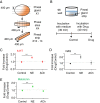Serotonin modulates melatonin synthesis as an autocrine neurotransmitter in the pineal gland
- PMID: 34675083
- PMCID: PMC8639368
- DOI: 10.1073/pnas.2113852118
Serotonin modulates melatonin synthesis as an autocrine neurotransmitter in the pineal gland
Abstract
The pineal gland secretes melatonin principally at night. Regulated by norepinephrine released from sympathetic nerve terminals, adrenergic receptors on pinealocytes activate aralkylamine N-acetyltransferase that converts 5-hydroxytryptamine (5-HT, serotonin) to N-acetylserotonin, the precursor of melatonin. Previous studies from our group and others reveal significant constitutive secretion of 5-HT from pinealocytes. Here, using mass spectrometry, we demonstrated that the 5-HT is secreted primarily via a decynium-22-sensitive equilibrative plasma membrane monoamine transporter instead of by typical exocytotic quantal secretion. Activation of the endogenous 5-HT receptors on pinealocytes evoked an intracellular Ca2+ rise that was blocked by RS-102221, an antagonist of 5-HT2C receptors. Applied 5-HT did not evoke melatonin secretion by itself, but it did potentiate melatonin secretion evoked by submaximal norepinephrine. In addition, RS-102221 reduced the norepinephrine-induced melatonin secretion in strips of pineal gland, even when no exogenous 5-HT was added, suggesting that the 5-HT that is constitutively released from pinealocytes accumulates enough in the tissue to act as an autocrine feedback signal sensitizing melatonin release.
Keywords: N-acetylserotonin; melatonin; pineal gland; plasma membrane monoamine transporter; serotonin receptor.
Conflict of interest statement
The authors declare no competing interest.
Figures








Similar articles
-
Norepinephrine triggers Ca2+-dependent exocytosis of 5-hydroxytryptamine from rat pinealocytes in culture.J Neurochem. 2002 May;81(3):533-40. doi: 10.1046/j.1471-4159.2002.00839.x. J Neurochem. 2002. PMID: 12065661
-
The role of the intracellular and extracellular serotonin in the regulation of melatonin production in rat pinealocytes.J Pineal Res. 1997 Sep;23(2):63-71. doi: 10.1111/j.1600-079x.1997.tb00337.x. J Pineal Res. 1997. PMID: 9392444
-
Hypocretin (orexin) in the rat pineal gland: a central transmitter with effects on noradrenaline-induced release of melatonin.Eur J Neurosci. 2001 Aug;14(3):419-25. doi: 10.1046/j.0953-816x.2001.01655.x. Eur J Neurosci. 2001. PMID: 11553292
-
Metabotropic glutamate receptors negatively regulate melatonin synthesis in rat pinealocytes.J Neurosci. 1998 Mar 15;18(6):2056-62. doi: 10.1523/JNEUROSCI.18-06-02056.1998. J Neurosci. 1998. PMID: 9482792 Free PMC article. Review.
-
Control of CREB phosphorylation and its role for induction of melatonin synthesis in rat pinealocytes.Biol Cell. 1997 Nov;89(8):505-11. doi: 10.1016/s0248-4900(98)80006-3. Biol Cell. 1997. PMID: 9618900 Review.
Cited by
-
Wasp Venom Ameliorates Scopolamine-Induced Learning and Memory Impairment in Mice.Toxins (Basel). 2022 Apr 4;14(4):256. doi: 10.3390/toxins14040256. Toxins (Basel). 2022. PMID: 35448865 Free PMC article.
-
Effectiveness of Acupressure on Sleep Quality Among Inpatients: A Systematic Review and Meta-Analysis.Nurs Health Sci. 2025 Mar;27(1):e70075. doi: 10.1111/nhs.70075. Nurs Health Sci. 2025. PMID: 40049603 Free PMC article.
-
Impairment of exocytotic transmitter release by decynium-22 through an inhibition of ion channels.Front Pharmacol. 2023 Oct 10;14:1276100. doi: 10.3389/fphar.2023.1276100. eCollection 2023. Front Pharmacol. 2023. PMID: 37881182 Free PMC article.
-
Mechanism of Melatonin Metabolism by CYP1A1: What Determines the Bifurcation Pathways of Hydroxylation versus Deformylation?J Phys Chem B. 2022 Nov 24;126(46):9591-9606. doi: 10.1021/acs.jpcb.2c07200. Epub 2022 Nov 15. J Phys Chem B. 2022. PMID: 36380557 Free PMC article.
-
Physical Activity as a Central Pillar of Lifestyle Modification in the Management of Chronic Musculoskeletal Pain: A Narrative Review.J Funct Morphol Kinesiol. 2025 May 20;10(2):183. doi: 10.3390/jfmk10020183. J Funct Morphol Kinesiol. 2025. PMID: 40407467 Free PMC article. Review.
References
-
- Klein D. C., et al. ., The melatonin rhythm-generating enzyme: Molecular regulation of serotonin N-acetyltransferase in the pineal gland. Recent Prog. Horm. Res. 52, 307–357, discussion 357–358 (1997). - PubMed
-
- Sun X., Liu T., Deng J., Borjigin J., Long-term in vivo pineal microdialysis. J. Pineal Res. 35, 118–124 (2003). - PubMed
-
- Møller M., Baeres F. M., The anatomy and innervation of the mammalian pineal gland. Cell Tissue Res. 309, 139–150 (2002). - PubMed
-
- Masson J., Emerit M. B., Hamon M., Darmon M., Serotonergic signaling: Multiple effectors and pleiotropic effects. Wiley Interdiscip. Rev. Membr. Transp. Signal. 1, 685–713 (2012).
Publication types
MeSH terms
Substances
Grants and funding
LinkOut - more resources
Full Text Sources
Miscellaneous

